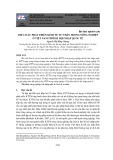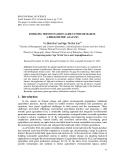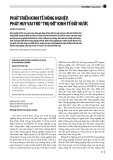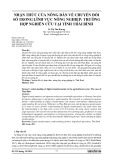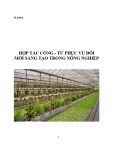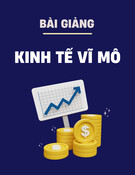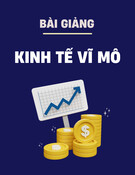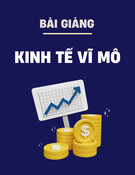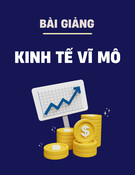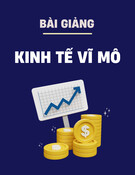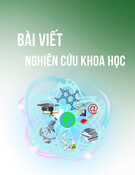
Journal of Development and Integration, No. 78 (2024)
60
Digital agriculture in economic
development in Vietnam
Le Hoang Tien1, *, Le Binh2, Chau Ngoc Han2
1Ho Chi Minh City University of Economics and Finance, Vietnam
2ECOHAUS Construction Management And Design Company Limited, Vietnam
K E Y W O R D S A B S T R A C T
Digital agriculture,
Smart agriculture, Internet
of Things, IoT.
Digital agriculture, incorporating artificial intelligence, IoT, and big data, is becoming a
crucial trend in Vietnam to address challenges posed by population growth and climate
change. The Ministry of Agriculture and Rural Development has devised a Digital
Transformation Plan to confront these challenges, particularly significant in a nation
heavily reliant on agriculture. Our research employs a multi-method approach to assess
the contribution of digital agriculture to Vietnam’s economic development, focusing on
private enterprises and public-private collaborations. Results demonstrate that digital
agriculture has enhanced resource management and agricultural productivity. This study
provides detailed insights into the current status and potential of digital agriculture in
Vietnam, highlighting the roles of private enterprises and public-private partnerships in
the nation’s digital transformation.
* Corresponding author. Email: tienlh@uef.edu.vn
https://doi.org/10.61602/jdi.2024.78.08
Received: 22-Feb-24; Revised: 08-May-24; Accepted: 12-May-24; Online: 19-Aug-24
ISSN (print): 1859-428X, ISSN (online): 2815-6234
1. Introduction
The term “digital agriculture” refers to the
integration of computers and electronic devices
in farming and other agricultural activities. This
approach allows farmers to enhance food production
through the adoption of advanced technologies.
Digital farming encompasses a comprehensive
database containing information ranging from soil
conditions to market assessments. This system serves
as a crucial tool for managing agricultural risks,
evaluating climate change impacts, establishing
revenue protection policies, and implementing soil
quality management programs (Ahmed, 2022).
Vietnam, heavily reliant on agriculture with a
2020 GDP contribution of 14.85%, faces challenges
in its agricultural sector due to population growth,
urbanization, and climate change (Swe Htet, 2021).
To adapt to these challenges, the sector is turning
to digital transformation and the application of
high technology. This strategic shift is anticipated
to improve production productivity, enable climate
change adaptation, ensure farmers’ income, and
reduce food waste (Thang et al., 2021).
Experts emphasize that swift digital transformation
is pivotal for Vietnam’s agriculture to recover
No. 78 (2024) 60-66 I jdi.uef.edu.vn

61
Journal of Development and Integration, No. 78 (2024)
and thrive in the post-pandemic era. Positioned
as a key pillar of the country’s economic growth,
digitalization is seen as a solution to challenges
posed by climate change, market fluctuations, and
evolving consumption trends. It is anticipated to
usher in a new era for the sustainable development
of Vietnam’s agricultural industry (Truong, 2022).
The Digital Transformation Plan aims to facilitate
a comprehensive and cost-effective shift towards
digitalization within the Ministry of Agriculture
and Rural Development. By seeking support and
collaboration from businesses and IT associations,
the plan aims to move beyond awareness and initiate
concrete actions for digital transformation across
various agencies and units. Specifically focused on
the agricultural sector, the plan aims to cultivate a
professional work culture emphasizing values such
as creativity, cooperation, sharing, respect, and a
sense of community responsibility. The overarching
goal is to align with the key objectives set by the
National Committee on Digital Transformation for
the Ministry of Agriculture and Rural Development
in 2023 (Thanh, 2023).
The agriculture sector plays an important role
in agriculture development in Viet Nam, and it
witnessed a significant transformation through
application digital. Our research questions are
formulated as:
RQ1: How is digital agriculture contributing to
the economic development in Viet Nam?
RQ2: What is the scale and extent of digital
technology adoption in the agricultural sector in
Viet Nam?
To investigate these inquiries, we utilized a multi-
method approach, as preliminary research suggested
that digital applications have not been widely
implemented in Vietnam. It is essential to emphasize
that our research outcomes aim to provide a general
overview of the potential for digital transformation
within the agricultural sector in Vietnam, rather than
focusing on specific applications (Loi, 2022).
2. Literature review
2.1. Overview of digital agriculture
Digital agriculture involves leveraging data
and artificial intelligence to enhance agricultural
practices globally, encompassing the entire food
production and distribution chain (Casto, 2021).
This approach integrates precision farming and
smart farming through the implementation of
intelligent software and hardware. Digital farming
can be achieved by deploying network-connected
‘smart’ devices as part of the Internet of Things
(IoT) or through software-as-a-service (SaaS) based
agricultural technology (agtech). In the realm of IoT
in agriculture, various tools such as sensors, drones,
robots, and cameras are installed on farms to capture
and record data. However, it’s important to note
that IoT requires technical expertise for operating
the equipment, and it entails high maintenance and
setup costs (Cropin, n.d.).
2.2. Global trends in digital agriculture
The field of smart agriculture, also known as
smart farming, has experienced significant growth
recently, increasing from $15 billion in 2022, its
market value is expected to grow up to $33 billion
by 2027 (infopulse, 2023). The trend of deploying
advanced technology in agriculture is increasingly
essential due to challenges such as population
growth (expected to reach 9.1 billion by 2050), high
resource consumption, and air pollution issues (with
agriculture contributing 40%). Technology plays a
crucial role in enhancing food production, optimizing
resource utilization, and mitigating environmental
pollution (infopulse, 2023).
According to a recent McKinsey report, farmers
in Europe and North America lead the global
adoption of agtech, with adoption rates at 62% and
61%, respectively. In terms of specific solutions
implemented in agricultural settings, farm workflow
management software takes the lead, being adopted
by 21% of farmers, followed by sensor and precision
agriculture systems, utilized by 15% of farmers
(infopulse, 2023).
2.2.1. Artificial Intelligence
In the digital agriculture trends of 2024, Gen AI or
generative AI is considered one of the most important
points. Gen AI’s potential for the global economy is
estimated to be in the trillions of dollars, opening up
historic opportunities to optimize processes, reduce
costs, and drive innovation through innovative models.
decisive move. Tools like Digital Crop Advisors use
Gen AI to transform agronomic data into actionable
recommendations for farmers, providing AI-powered
Le Hoang Tien et al.

Journal of Development and Integration, No. 78 (2024)
62
insights to optimize crop management and shape
performance across crops. farm. This helps farmers
understand the factors that affect crops and production
on their farms, and respond to climate change through
monitoring climate trends (Ron, 2023).
2.2.2. IoT and smart sensors
The popularity of sensors and IoT in agriculture
is driven by their valuable applications (infopulse,
2023):
Crop Management: IoT devices monitor plant
health and moisture for disease detection and
optimized irrigation, preventing crop damage
Greenhouse Monitoring: Measures temperature,
lighting, humidity, and soil conditions in greenhouses
to enhance resource efficiency and yield.
Cattle Supervision: IoT sensors on animals
monitor health and activities, preventing potential
infections.
Smart Irrigation: Soil moisture sensors aid
agronomists in precise water level determination for
efficient irrigation planning.
Fertilizer Management: Electrochemical sensors
analyze soil parameters for informed decisions on
seed planting and fertilizer application.
2.2.3. Others technologies for digital agriculture
Big Data: offering great opportunities for farmers to
manage resources effectively, optimize productivity,
and reduce global poverty. Precision agriculture uses
data from multiple sources such as GPS, sensors,
and drones to optimize processes and reduce waste.
Resource management, by monitoring irrigation
water, and reducing erosion, and energy, is also
improved through big data savings. Market analysis
relies on big data to predict trends and help farmers
decide on farming strategies. Weather forecasting
uses big data to provide accurate information to help
farmers plan planting, irrigation, and harvest. In the
agricultural lending sector, big data is being used
to assess credit risk, providing better financing for
farmers. All these improvements bring transparency
to agricultural production and increase trust between
consumers and farmers (Bankbarn, n.d.).
Biotechnology: Biotechnology is providing
farmers with effective tools, from herbicide-tolerant
crops to nutritious foods. Genetically modified crops
help control pests and pollution, and biotechnology
also contributes to the production of antibiotics and
vaccines for animals. This helps improve efficiency
and sustainability in agriculture (USDA, n.d.).
2.3. Previous studies on digital agriculture in Viet
Nam
Figure 1. Artificial Intelligence (AI) in Digital Agriculture (Jain, 2020)
Le Hoang Tien et al.

63
Journal of Development and Integration, No. 78 (2024)
Agritech (Agtech) integrates technology into
agriculture for increased production, efficiency,
and profits. In Vietnam, startups are developing
environmentally friendly, affordable, and easily
integrable solutions. They focus on reducing gaps in
food and water access, catering to safe dietary needs,
setting them apart from regional competitors. Despite
being an agricultural country, Vietnam’s high-tech
agricultural sector lags due to numerous smallholder
farmers and a shortage of agricultural enterprises and
innovation. Agricultural tech businesses represent a
small portion of the market compared to the vast agri-
food workforce. However, Vietnam’s agricultural
industry is booming, with startups innovating
and expanding into Southeast Asian markets.
Collaboration between businesses, startups, and
farmers through contracts is a growing and favorable
trend. Global organizations and associations strongly
support Vietnam’s AgTech sector (Innolab, 2023).
Figure 2. IoT for Smart Agriculture (Quy et al., 2022)
Figure 3. Big Data in Digital Agriculture (N-iX, 2023)
Le Hoang Tien et al.

Journal of Development and Integration, No. 78 (2024)
64
3. Methodology
The employed methodology in this study is
based on established systematic review procedures,
encompassing search strategies, data extraction,
and result reporting (Loi, 2022), as outlined by
Kitchenham and Charters (2007). Such an approach
is suitable as a research method when the aim is to
investigate specific topics, theoretical perspectives, or
issues within a particular field of study or expertise
to identify elements of a concept or a new approach
(Snyder, 2019). It is currently extensively utilized in
agricultural research (Koutsos et al., 2019).
As a result, we established a category of scientific
articles employing keywords associated with digital
agriculture, including digital agriculture, digital/smart
farming, technology, and agriculture 4.0. The majority
of these documents were published between 2017
and 2021. Deductive content analysis was utilized to
scrutinize the retrieved documents, aiming to identify
the conditions and potentials for the development of
digital agriculture.
In response to ‘RQ1: How is digital agriculture
contributing to the economic development in Viet
Nam?’. In response to RQ1, we examined abstracts
to ensure the emphasis on agriculture and digital
technology. We systematized concepts, defining the
essence of digital agriculture and identifying attributes
crucial for its transformation. With the aid of official
statistics, we presented a comprehensive overview
of the digital agricultural transformation in Vietnam.
Notably, during the pandemic, digitization served as
the cornerstone for the modernization of economic
sectors, fostering the emergence of new business
models adaptable to the current reality.
Thus, to answer ‘What is the scale and extent of
digital technology adoption in Vietnam’s agricultural
sector?’. To address RQ2, we thoroughly searched
materials to pinpoint cases illustrating how digital
technology has been applied in Vietnamese agricultural
production. Our goal was to ascertain the extent and
scale of digital technology adoption in the agricultural
sector. In conclusion, we assessed the study’s outcomes
and drew conclusions regarding the current prospects
for the development of digital agriculture in Vietnam,
ensuring no duplication with the references.
4. Results and discussion
4.1. Digital agriculture in Viet Nam
In the realm of digital agriculture in Vietnam,
private companies play a central role as primary
solution providers. Notable entities in this domain
include VinEco, Hachi, TH True Milk, Vinamilk,
Agrimedia, GreenCoffee, MimosaTEK, BacTom,
RTAnalytics, Fsoft, TraceVerify, and the Digital
Agriculture Association of Vietnam (Innolab, 2023).
The progress of digital agriculture innovation has
been significantly boosted through public-private
Figure 4. Biotechnology in Digital Agriculture (Samuel, 2023)
Le Hoang Tien et al.




